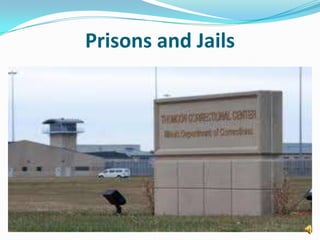
Prisons And Jails
- 2. Prisons There are about 1,325 state prisons and 84 federal prisons in operation in United States today.1 The prison population increased 700% from 1970 to 2005.2 Because of the growth of prison population, the government is going to fund and construct more and more prisons. The rate of crime dropped until recently because the increased rate of incarceration removed from the community those who are likely to reoffend.
- 3. Characteristics of prisons About 68% of state prisoners lack a high school diploma. Half are functionally illiterate. About 53% of state prisoners are dependent on drugs. The work histories and skills of prisoners are well below those of the general population.3
- 4. Purposes of prisons One of the purposes of prisons is to rehabilitate and help inmates who are lacking a high school diploma, illiterate, or dependent on drugs. The central aim of a true prison system is the protection of society against crime, not the punishment of criminals.(Zebulon R. Brockway, 1827-1920).
- 5. Overcrowding Prison overcrowding can be measured along a number of dimensions. Space available per inmate. Length of confinement of inmates in cells or housing units. Living arrangements. Type of housing.
- 6. Prison capacity Rated capacity refers to the size of the inmate population that a facility can handle according to the judgment of experts. Operational capacity is the number of inmates that a facility can effectively accommodate based on an appraisal of the institution’s staff, programs, and services. Design capacity refers to the inmate population that the institution was originally built to handle.
- 7. Maximum security levels High fences. Thick walls. Secure cells. Gun tower. Armed prison guards.
- 8. Medium security level Prison yard. Exercise room. Library. Showers.
- 9. Minimum security level Recreational, educational, and skill training programs. No fences. No gun towers. No armed guards. The above is also used a type of classification system with more serious offenders put in maximum security facilities and less serious offenders in medium to minimum security facilities.
- 10. Federal Prison System Beside the operations of state prisons, the Federal Prison System operates simultaneously: 103 institutions. 6 regional offices. The Central Office. 2 staff-training centers. 28 community correction offices.4
- 11. Jails A similar aspect to prison is Jail. Jails are locally operated, short-term confinement facilities. There are total of 3,360 jails that operate throughout the United States today.5
- 12. Purposes of Jails Readmitting probation, parole, bail-bond violators. Detaining juveniles, mental ill temporarily. Transferring inmates to federal, states, or other authorities. Holding inmates sentenced to short term ( under 1 year). Releasing convicted inmates to the community upon completion of their sentences, etc… Operating community –based programs with day reporting, home detention, electronic monitoring, or other types of supervision.
- 13. Problems of Jails Women in jails occupy 12% of jail population.6 Many of them are drugs addicts, illiterate. Because the lack of female officers who work in jails, women in jails are at risk to be abused by male staff.(Ibid., p.6).
- 14. Children born in jails Many women are pregnant before going to jails. There fore, few hundred children are born in jail each year. Their mothers may have to pay for their support.
- 15. Disadvantages of jails Being run by people that are too old. Poorly funded.(The cost for incarcerating an inmate is about $47,000 per year, but only $17,000 in jail). Poorly trained employees. Overcrowded. Misused of detention.
- 16. Conclusion Building new prisons and jails may be good because they create more jobs locally that impact a part of the economy. It can stand to help with overcrowding if enough are built. Nowadays, the government has plans for improving and developing jails systems as well prisons systems. The private prison is also a solution for avoiding “overcrowded”.
- 17. Sources 1. Washington DC: Bureau of Justice Statistics, 2003. 2. Philadelphia: Pew, February 2007, p.1. 3. Kessler, The Impending Crime Wave, p.7. 4. Federal Bureau of Prisons, Staff Breakdown, http://www.bop.gov/about/facts.jsp #5. 5. Stephan, Census of Jails, 1999. 6. American Jails, Vol. 4, No. 3. William Reginald Mills and Heather Barrett.
